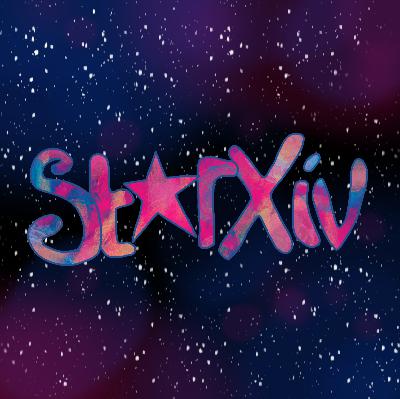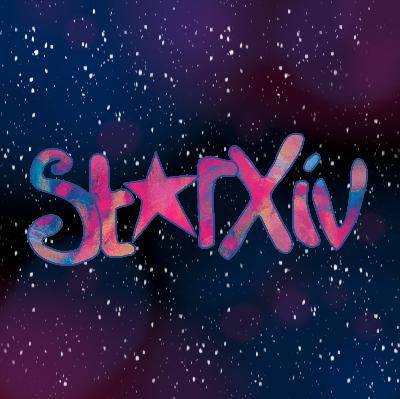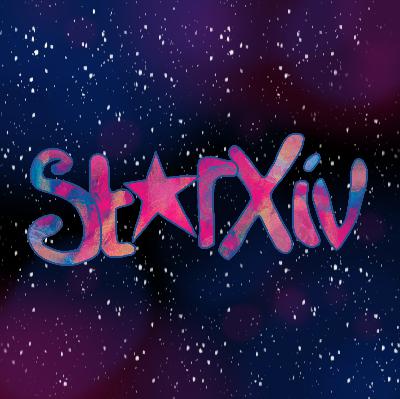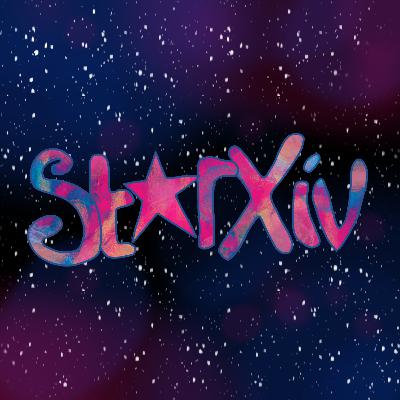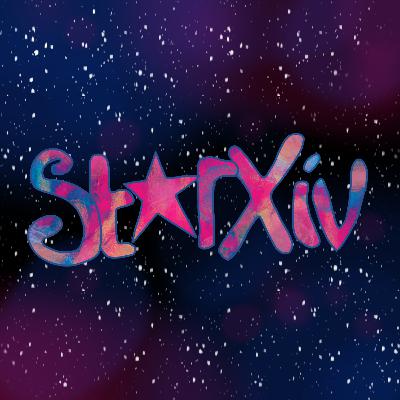Discover StarXiv: a podcast discussing the latest astronomy papers
StarXiv: a podcast discussing the latest astronomy papers

StarXiv: a podcast discussing the latest astronomy papers
Author: Michelle and Payel
Subscribed: 2Played: 96Subscribe
Share
© Michelle and Payel
Description
Hello! Welcome to the StarXiv, hosted by Dr Michelle Collins and Dr Payel Das. This is a biweekly podcast that delves into the latest astronomy papers & results from the arXiv. Michelle and Payel are astronomers at the University of Surrey. They love research, but struggle to find time to read a lot of papers. They’re hoping this podcast fixes that. The beautiful logo is designed by Izzy Gray, a PhD student currently studying at the University of Surrey.
27 Episodes
Reverse
This episode, Payel and Nicole discuss how to generate alpha-bimodalities in Milky-Way-like galaxies without major mergers or radial migration, a new search for radio emission from the elusive intermediate-mass black hole of Omega Centauri , detailed chemical DNA measurements of the oldest stars in the Small Magellanic Cloud, and searching for dwarfs using HI measurements. Check out the papers we discussed below:Portrait of a Galaxy on FIRE: Is the $α$-bimodality a natural consequence of inside-out disc growth in a hierarchical formation scenario? - Maria BenitoNo evidence for accretion around the intermediate-mass black hole in Omega Centauri - Angiraben D. MahidaThe chemical DNA of the Magellanic Clouds V. R-process dominates neutron capture elements production in the oldest SMC stars - Lorenzo SantarelliTiNy Titans HI: Discovering Satellites via HI Gas in an Isolated, Compact Group of Dwarf Galaxies - Sabrina Stierwalt
This episode, Payel and Nicole discuss streamer-like structures around protostellar sources, a multiply imaged Little Red Dot with an apparent blue companion, age and metallicity of low-mass galaxies, starspots and flares, and exploring the ultra-faint dwarf Bootes I using JWST and HST. Check out the papers we discussed below:A tale of three tails: A misaligned streamer and mysterious structures around [BHB2007]1 - Aashish GuptaVENUS: When Red meets Blue -- A multiply imaged Little Red Dot with an apparent blue companion behind the galaxy cluster Abell 383 - Miriam GolubchikAge and metallicity of low-mass galaxies: from their centres to their stellar halos - Elisa A. TauStarspots and Flares are Generally Not Correlated - Andy B. ZhangExploring the ultra-faint dwarf Bootes I using JWST and HST: Metallicity distribution and binaries - Fabrizio Muratore
This episode, Michelle, Payel, and Nicole discuss simulating individual stars, exoplanets born outside of the Milky Way, the intracluster medium as a window to past merging activity, the chemical versus kinematic thin and thick discs of the Milky Way, early formation of supermassive black holes, and galaxy mergers as cosmic ray sources.Check out the papers we discussed belowEDGE-INFERNO: How chemical enrichment assumptions impact the individual stars of a simulated ultra-faint dwarf galaxy - Eric AndersonSearching for Exoplanets Born Outside the Milky Way: VOYAGERS Survey Design - Robert AloisiThe Quiescent Merging Nature of the Coma Cluster Revealed by ICM Velocity Structure - Efrain GatuzzImpact of selection criteria on the structural parameters of the Galactic thin and thick discs - Simon AlinderEarly Formation of Supermassive Black Holes via Dark Star Gravitational Instability - Katherine FreeseGalaxy Mergers Collectively Illuminate the γ-Ray Sky - Jaya Doliya
This episode, Michelle and Payel discuss the Solar birth cluster, young stars with high alpha abundances, the formation of intermediate mass black holes, decelerated expansion of the Universe, strong lens detection in Euclid and predicting solar flares. Check out the papers we discussed below:Spectroscopic Follow-up of Young High-α Dwarf Star Candidates: Still Likely Genuinely Young - Yuxi LuLimits on Stellar Flybys in the Solar Birth Cluster - Amir Siraj, Christopher F. Chyba, Scott TremaineStrong Progenitor Age-bias in Supernova Cosmology. II. Alignment with DESI BAO and Signs of a Non-Accelerating Universe - Junhyuk SonSeeds to success: growing heavy black holes in dense star clusters - Lavinia PaiellaSolar flare forecasting with foundational transformer models across image, video, and time-series modalities - S. Riggi et al.Euclid Quick Data Release (Q1). Searching for giant gravitational arcs in galaxy clusters with mask region-based convolutional neural networks - Euclid Collaboration, L. Bazzanini, et al.
In this episode, Michelle and Nicole discuss what sets the chemistry of the faintest galaxies and RR-Lyrae stars, how to trace the proto-Galaxy, why some galaxies fail to thrive, can quasi-stars can explain Little Red Dots, and whether UNIONS 1 is a galaxy or a star cluster. Tune in below, on Spotify, Apple or wherever you get your podcasts.
In this episode, Payel and Nicole discuss what happens to the metallicity gradient of a satellite galaxy after it merges with its host, the existence of intermediate-age RR lyrae and radio rings, the possibility of determining the history of the inner Milky Way from radially migrated stars, and the possibility of finding more Einstein rings using a new approach that utilises both spectra and images. From order to chaos: the blurred out metallicity gradient of the Gaia-Enceladus/Sausage progenitor - Andreia Carillo et al.First direct detection of an RR Lyrae star conclusively associated with an intermediate-age cluster - Cecilia Mateu et al.RAD@home discovery of extragalactic radio rings and odd radio circles: clues to their origins - Ananda Hota et al.A New Way to Discover Strong Gravitational Lenses: Pair-wise Spectroscopic Search from DESI DR1 - Yuan-Ming Hsu et al.Chronology of our Galaxy from Gaia colour-magnitude diagram fitting (ChronoGal): IV. On the inner Milky Way stellar age distribution - Tomás Ruiz-Lara et al.
In this episode, Michelle and Nicole discuss merger debris around a distant spiral galaxy, metal-mixing around pop III stars, quasi-periodic eruptions in Ansky, relic galaxies, Mercury's magnetosphere and second generation stars in globular clusters. Listen below, on Spotify, Apple Podcasts or wherever you get your podcasts.
In this episode of the StarXiv Michelle and Payel talk about very massive and less massive black holes, the possibility of feedback free star formation, dark galaxies, runaway dwarf galaxies and the chance of life in the faintest galaxies.Check out the papers below!AGN-heated dust revealed in "Little Red Dots - I Delvecchio et al.Is feedback-free star formation possible? - A. Ferrara et al.The First RELHIC? Cloud-9 is a Starless Gas Cloud - Gangadeep Anand et al.An isolated early-type dwarf galaxy that ran away from the group environment - Sanjaya Paudel et al.Are Local Group Dwarf Spheroidal Galaxies the First Safe Planet-hosting Environments? - Stefano Ciabattini, Stefania Salvadori, Leonardo TestiNew gravitational-wave data support a bimodal black-hole mass
This episode, Michelle and Payel reunite to discuss the chemistry of nearby M-dwarf stars, where the majority of stars form in the Milky Way, whether giant planets naturally form at large distances from their hosts, extending the search for supermassive black holes and the search for alien technosignatures. Check out the papers we discussed below!The origin of extreme N-emitters in star-forming galaxies at z<0.5 with DESI DR1 - Souradeep Bhattacharya & Chiaki KobayashiHow many stars form in compact clusters in the local Milky Way? Alexis L. Quintana, Emily L. Hunt & Hanna ParulChemical evolution imprints in the rare isotopes of nearby M dwarfs - Dario Gonzalez-Picos et al.WIde Separation Planets In Time (WISPIT): A Gap-clearing Planet in a Multi-ringed Disk around the Young Solar-type Star WISPIT 2 - Richelle van Capelleveen et al.Glimmers in the Cosmic Dawn. III. On the Photometrically Determined Black Hole Mass to Stellar Mass Relation Across Cosmic Time - Alice Young et al.Technosignature Searches of Interstellar Objects - James Davenport et al.
In this episode, Michelle and Nicole dissect 5 papers, and accidentally find a common theme: disks! Whether in low mass galaxies, giant low surface brightness galaxies, the rotation curves of spirals or the natal environment of planetary systems, disks really are all around us. They also discuss the differences in chemistries between globular clusters that have been accreted or formed in-situ, just for a little bit of balance. Check out the episode below, on Spotify, Apple podcasts or wherever you get your podcasts.
In this episode, Michelle and Payel discuss the claimed detection of a starless dark matter subhalo, speedy, puffy white dwarfs, super massive black holes and how to form and grow them, smaller black holes and how to merge them, and star clusters in the Sparkler galaxy. Listen below, on Spotify, Apple podcasts or wherever you get your podcast.
In this episode, Michelle and Payel squash in more papers than ever, as Michelle delves into a flurry of papers about new newly discovered interstellar comet: 3I/ATLAS. They also discuss what sets the metallicities of the faintest galaxies, how nitrogen enrichment relates to gas density, the molten properties of a new ultra-short period planets, and how to find 'dak' galaxies! Find the papers we discuss in this episode below!What Sets the Metallicity of Ultra-Faint Dwarfs? - Vance Wheeler et alCLASSY XIV: Nitrogen Enrichment Shaped by Gas Density and Feedback - Karla C. Arellano-Cordova et al.Where are all the dark galaxies? Predicting galaxy/halo locations from their bright neighbors - Alice Chen & Niayesh AfshordiAn Earth-Sized Planet in a 5.4h Orbit Around a Nearby K dwarf - Kaya Han Tas et al.From a Different Star: 3I/ATLAS in the context of the Åtautahi-Oxford interstellar object population model - Matthew J. Hopkins et al.Interstellar comet 3I/ATLAS: discovery and physical description - Bryce T. Bolin et al.Initial VLT/MUSE spectroscopy of the interstellar object 3I/ATLAS - Cyielle Opitom et al.Discovery and Preliminary Characterization of
This episode, Michelle is back and she and Payel discuss long period pulsars, population III galaxies, latent variables in Galactic archaeology, accreted globular clusters, planets that cause their star to flare and avoiding photo0z catastrophes. Check out the papers we discussed this episode below!Metal-polluted PopIII galaxies and How to Find Them – Elka Rusta et al.Close-in planet induces flares on its host star – Ekaterina Ilin et al.Accreted Globular Clusters and Horizontal Branch Morphology in the Outer Halo of M31 – Gracie McGill et al.A binary origin of ultra-long period radio pulsars – Ying-Han Mao et al.Avoiding (photo-z) Catastrophe – A. J. Battisti et al.Causal Discovery of Latent Variables in Galactic Archaeology – Zehao Jin et al.
In this episode, we had Payel and Nicole filling in for Michelle who’s away on holiday. Nicole is a PhD student, also at the University of Surrey Astrophysics research group. They discuss the direct detection of HI beyond the local universe, how the Milky Way seems unusually cold, a planetary system with two misaligned planets, detecting stars of common origin through the ratio of alpha elements produced through hydrostatic channels to those produced through explosive ones, twin collisional-ring galaxies, and the impact of the initial mass function on chemical evolution at high redshift.Read this episode's papers through the links below!MIGHTEE-HI: The direct detection of neutral hydrogen in galaxies at z>0.25 - Matt J. Jarvis et al.Stellar Velocity Dispersion versus Age: Consistency across Observations and Simulations, with the Milky Way as an Outlier - Fiona McCluskey et al.JWST Coronagraphic Images of 14 Her c: a Cold Giant Planet in a Dynamically Hot, Multi-planet System - Daniella C. Bardalez Gagliuffi et al.Hydrostatic and explosive α-element chemical abundances of Milky Way globular clusters, halo substructures, and satellite galaxies - Danny Horta and Melissa NessThe Cosmic Owl: Twin Active Collisional Ring Galaxies with Starburst Merging Front at z=1.14 - Mingyu Li et al.Impact of initial mass function on the chemical evolution of high-redshift galaxies - Boyuan Liu et al.
In this episode, Michelle and Payel discuss why dark matter halos have a Universal density profile, how to age-date Pluto's surface with craters, delayed Pop III star formation, dwarf candidates in the UNIONS survey, a problem with Europium and whether Little Red Dots are really AGN. Listen below, on Spotify, Apple podcasts or wherever you get your podcasts!Read this episodes papers through the links below!Collisionless relaxation to quasi-steady state attractors in cold dark matter halos: origin of the universal NFW profile - Uddipan Banik, Amitava BhattacharjeePluto Geologic Map: Use of Crater Data to Understand Age Relationships - Kelsi N. Singer et al.Bursty or heavy? The surprise of bright Population III systems in the Reionization era - Alessandra Venditti et al.Galaxies OBserved as Low-luminosity Identified Nebulae (GOBLIN): a catalog of 43,000 high-probability dwarf galaxy candidates in the UNIONS survey - Nick Heesters et al.Europium, we have a problem. Modelling r-process enrichment across Local Group galaxies - Marco Palla et al.Lonely Little Red Dots: Challenges to the AGN-nature of little red dots through their clustering and spectral energy distributions - María de las Mercedes Carranza Escudero
This episode, Michelle and Payel are very on-theme as they discuss whether Little Red Dots can be explained by super Eddington accretion; the high abundances of nitrogen to oxygen in the most distant galaxies and whether this is tied to globular cluster formation; the stellar graveyard in galaxies, and claims of signs of life in distant world. Listen below, on Spotify, Apple podcasts or wherever you get your podcasts!Check out this episode's papers on the arXiv below!Super-Eddington accretion in high-redshift quasar hosts: black-hole driven outflows, galaxy quenching, and the nature of Little Red Dots - Giada Quadri et al.Connecting JWST discovered N/O-enhanced galaxies to globular clusters: Evidence from chemical imprints - Xihan Ji et alInsufficient evidence for DMS and DMDS in the atmosphere of K2-18 b. From a joint analysis of JWST NIRISS, NIRSpec, and MIRI observations - R. Luque et al.Chandra Rules Out Super-Eddington Accretion For Little Red Dots - Andrea Sacchi and Akos BogdanA Cosmic Miracle: A Remarkably Luminous Galaxy at zspec=14.44 Confirmed with JWST - Rohan Naidu et alStellar population modelling of neutron stars and black holes: spatially-resolved graveyards in MaNGA/SDSS-IV galaxies - Claudia Maraston et al.
In this episode, Michelle and Payel discuss whether wandering intermediate black holes are mythical or not, how planes of satellites may form from cosmic accretion, how to form double hot Jupiters, whether Kelper's supernova remnant is an 'alien', whether Unions I is the faintest star cluster or the faintest galaxy, and just how old our globular clusters are. Listen below or check us out on Spotify, Apple Podcasts, or wherever you get your podcasts.You can check out all the papers we discuss this episode using the links below!Wandering intermediate-mass black holes in Milky Way-mass galaxies in cosmological simulations: myth or reality? - Floor van DonkelaarZippers and Twisters: Planes of Satellite Galaxies Emerge from Whirling and Shocking Gas Streams in the Cosmic Web - Janvi P. Madhani et al.Double Hot Jupiters Through ZLK Migration - Yurou Liu, Tiger Lu and Malena RiceAlien-Type-Ia supernovae from the Milky Way merger history and one possible candidate -- Kepler's supernova - Wenlang He et al.Reevaluating UMa3/U1: star cluster or the smallest known galaxy? - Scot Devlin et al.The Absolute Age of Milky Way Globular Clusters - Jiaqi Ying et al.
This episode, Michelle and Payel delve into the latest constraints on mixed dark matter from the Lyman alpha forest, what happens to stars that get a little too close to a black hole, how machine learning can help identify stars likely to host an Earth-like planet, studying the dark ages from the Moon and witnessing the birth of nuclear star clusters! Check out the episode and papers below!Constraining Mixed Dark Matter models with high redshift Lyman-alpha forest data - Olga Garcia-Gallego et al.Black Hole Survival Guide: Searching for Stars in the Galactic Center That Endure Partial Tidal Disruption - Rewa Clark Bush et al. Earth-like planet predictor: A machine learning approach - Jeanne Davoult et al.Detecting the 21 cm Signal of the Cosmic Dark Ages - Willow Smith and Jonathan PoberEvidence of star cluster migration and merger in dwarf galaxies - Mélina Poulain et al.
In this episode, Payel and Michelle discuss how you can slow down a galaxy’s bar, scaling relations for black holes, whether we can use intracluster light to learn about dark matter, little red dots, AI cosmologists and pasta sauce for all your plotting needs! Check out our episode – and the papers that inspired it – below.Tidal interaction can stop galactic bars: on the LMC non-rotating bar– Óscar Jiménez-Arranz & Santi Roca-FabregaEvidence for evolutionary pathway-dependent black hole scaling relations – Jonathan Cohn et al.pastamarkers 2: pasta sauce colormaps for your flavorful results – The PASTA collaborationIntracluster light is a biased tracer of the dark matter distribution in clusters – J. Butler et al.Formation of the Little Red Dots from the Core-collapse of Self-interacting Dark Matter Halos – Fangzhou Jiang et alThe AI Cosmologist I: An Agentic System for Automated Data Analysis – Adam Moss
In this episode, Payel and Michelle discuss the longest period pulsar, the formation of nuclear star clusters, the recent data releases from ACT and DESI, dark spiral arms and the problem with rotation curves.Papers in this episode:The discovery of a 41-second radio pulsar PSR J0311+1402 with ASKAP – Yuanming Wang et al.Seeding Cores: A Pathway for Nuclear Star Clusters from Bound Star Clusters in the First Billion Years – Fred Angelo Batan GarciaDark matter spiral arms in Milky Way-like halos – Marcel Benet et al.Data Release 1 of the Dark Energy Spectroscopic Instrument – The DESI collaborationThe Atacama Cosmology Telescope: DR6 Constraints on Extended Cosmological Models – Ermina Calabrese et alDecoding the Galactic Twirl: The Downfall of Milky Way-mass Galaxies Rotation Curves in the FIRE Simulations – Xiaowei Ou et al.


